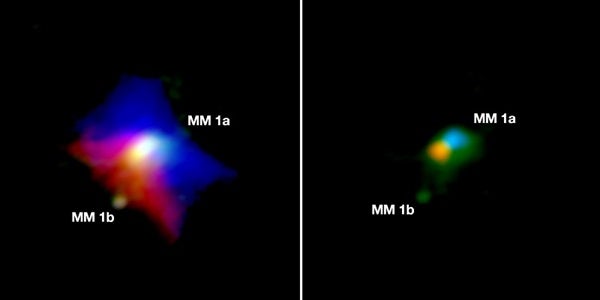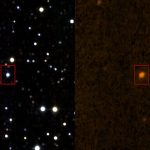Key Takeaways:
- Astronomers found a young massive star (MM 1a) forming another star (MM 1b) instead of planets within its disk.
- MM 1b likely formed from a fragment of MM 1a’s massive disk that couldn’t withstand its own gravity.
- Witnessing a star forming from another star’s broken disk is uncommon.
- The massive star (MM 1a) has a short lifespan and will likely explode in a supernova in about a million years.
- This discovery highlights the many mysteries surrounding star formation in our universe.
There are many surprises in the universe, and a massive young star has been hiding a stellar one.
While observing infant star MM 1a, astronomers found that its massive disk was actually forming another star instead of planets. The much smaller companion, known as MM 1b, was discovered slightly outside the dusty disk surrounding the massive star and may even contain a planet-forming disk of its own. The discovery of the new star, published in the Astrophysical Journal Letters, marks one of the first times astronomers saw a star forming in the fragmented disk of another.
Stellar Siblings
The formation of binary stars, which are rather common in the universe, is believed to occur from a massive cloud of gas and dust that collapses under the force of its own gravity, just like single stars do. A big enough molecular cloud can give birth to two stars of comparable size rather than just one.
Furthermore, the discovery of MM 1a surprised astronomers from the University of Leeds since binary pairs are relatively easy to find. Homing in on the seemingly single star, they found an unexpected, much smaller companion star lurking in the outskirts of its dense disk — the region of dust and gas where planets typically form.
John Ilee, head of the study and a researcher at the University of Leeds, said in a news release that “in this case, the star and disk we have observed is so massive that, rather than witnessing a planet forming in the disk, we are seeing another star being born.”

To shed light on the peculiar pair, the researchers used the Atacama Large Millimetre/submillimetre Array (ALMA) to probe the star system — observing the light frequencies that emit from the disk’s gas and measuring the radiation that emits from the disk’s dust. They used this information to calculate the mass of the stars, and found that MM 1a is about 40 times the mass of our Sun, and that MM 1b weighs just half our Sun’s mass.
The researchers believe that MM 1b was actually born in a fragment of MM 1a’s disk in order to explain this stark contrast. They think that because of its large mass, the disk broke apart into fragments because it was unable to withstand its own gravity. In addition to containing enough gas and dust to form the low mass companion star, one of those fragments may have also contained a planet-forming disk.
Unfortunately, both of these stars and their prospective planets will soon meet a grim end. Massive stars like MM 1a have relatively short lives, and in approximately a million years, a supernova will likely wipe out the entire system. In contrast, lower mass stars like MM 1b have long lifespans.
Despite the potentially catastrophic repercussions, this finding represents one of the rare occasions when astronomers have witnessed a star emerge from its companion’s broken disk. The discovery may aid in the understanding of the odd star systems in our universe and serve as a reminder that many star mysteries remain unanswered.


